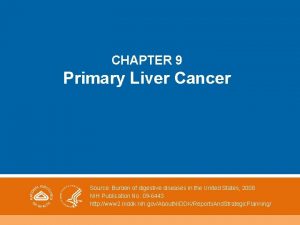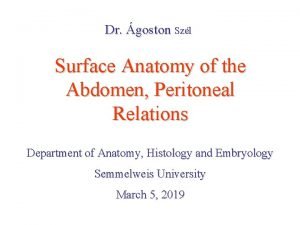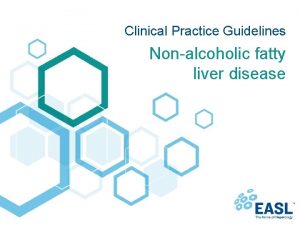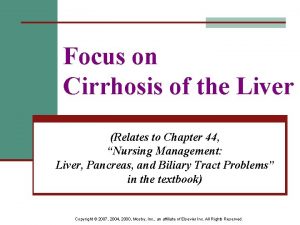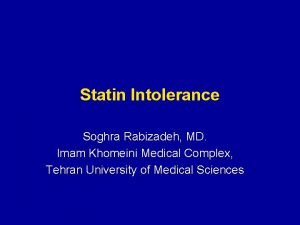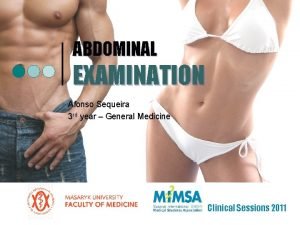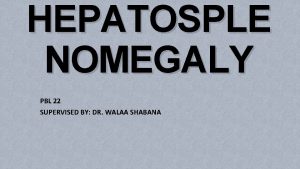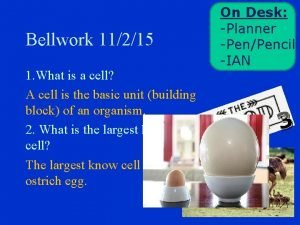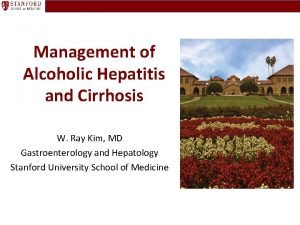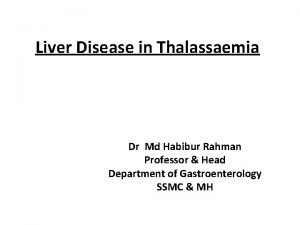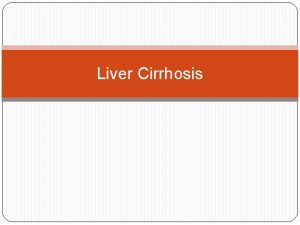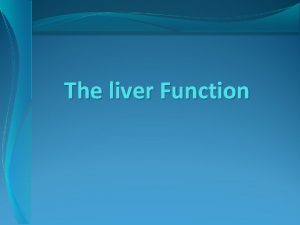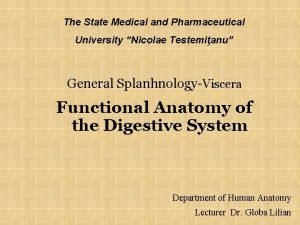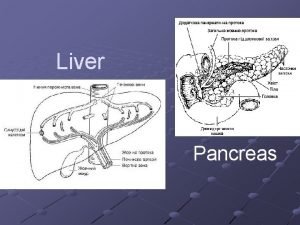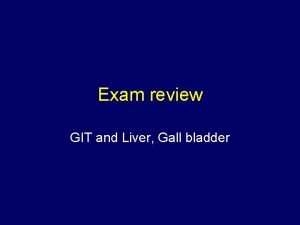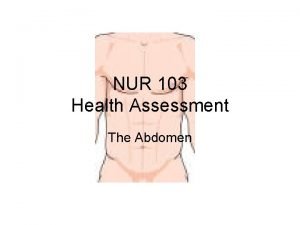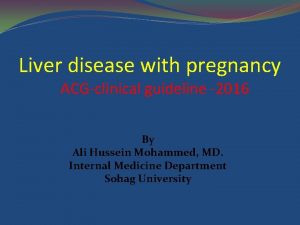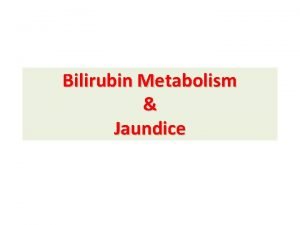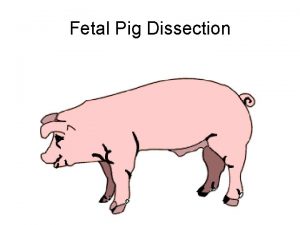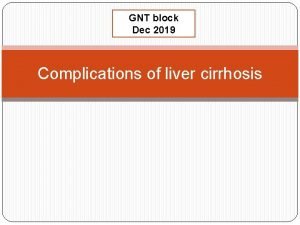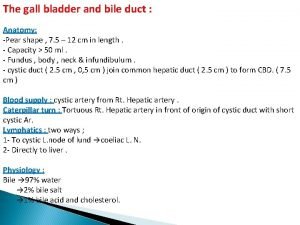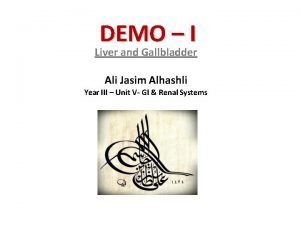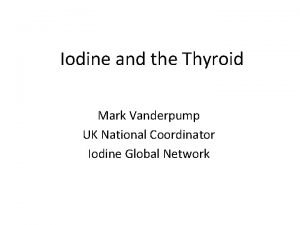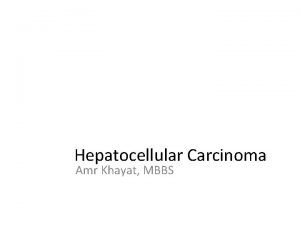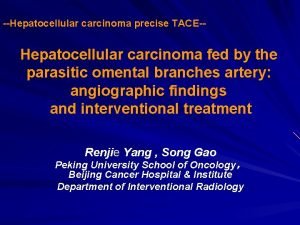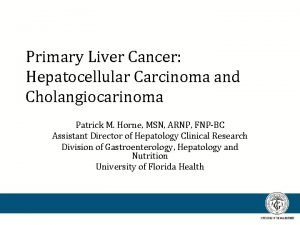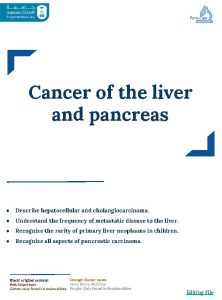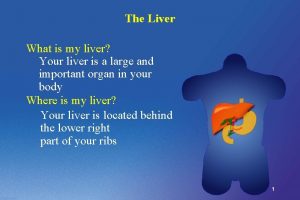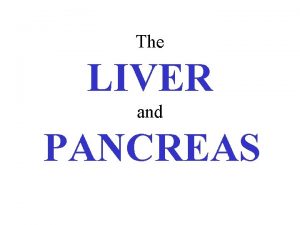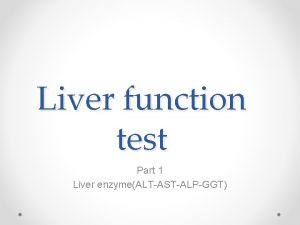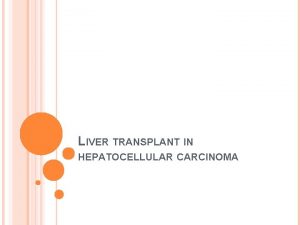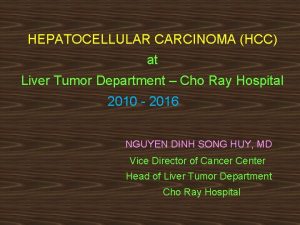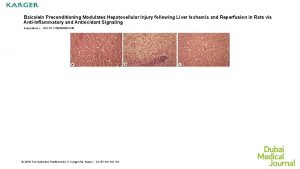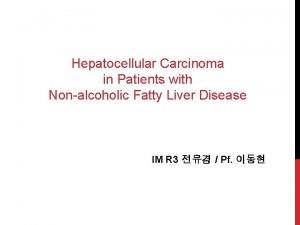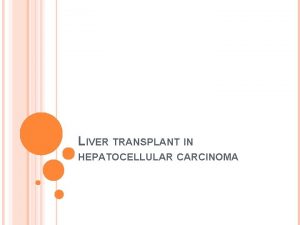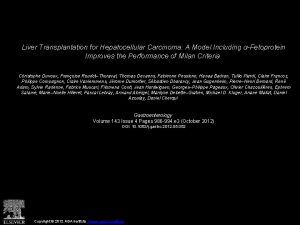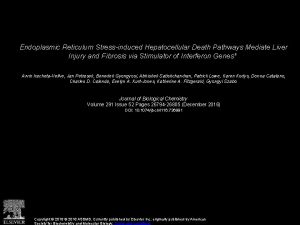Liver Cancer Intruduction Liver Cancer Hepatocellular carcinomais a




































- Slides: 36

Liver Cancer

Intruduction Liver Cancer (Hepatocellular carcinoma)is a cancer arising from the Liver. It is also known as Primary liver cancer. The majority of primary liver cancer (over 90 -95%)Arises from liver cells.

Definition Liver cancer is a Cancer which starts in the liver rather than migrating to the liver from another organ. Liver cancer is a disease condition of the liver in which cancer that forms in the tissues of the Liver is called Liver Cancer.

Incidence In 2018 -16, 887, 80 New cases. Deaths- 6, 00, 920.

Liver Cancer Liver cancer is a cancer which originates in the liver There are 4 main types Hepatocellular carcinoma (HCC) Cholangiocarcinoma Angiosarcoma Hepatoblastoma The major types is Hepatocellular carcinoma (HCC)

Hepatocellular carcinoma (HCC) • This is the most common from of liver cancer in adults • Hcc is also called hepatoma • Hcc is the most common type of liver cancer approximately 75% • Most cases of Hcc are the result of infection with hepatitis B or Cirrhosis of liver.

Cholangio carcinoma (Bile Duct Cancer) • The cancer occurs in the small tube like Bile ducts with in the liver that carry Bile to gallbladder. • 10 -20%

Angio Sarcoma ( Hemangio Carcinoma) • Cancer is form in the blood vessels of the Liver & grow very quickly. • 1% of people will affected. • They are very typically diagnosed

Hepato Blastoma • This is very rare Kind of Cancer that develops in children (>4 year ) • 2 out 3 children with these tumors are treated successfully

Secondary Liver Cancer • It is also known as Liver Metastasis • It develops when primary cancer from another part of the body spreads to the liver. • Most liver metastasis originate from colon Or Colorectal Cancer. • Most people diagnosed with colorectal cancer developed secondary liver cancer

Stages of Liver Cancer TO- NO EVIDENCE OF PRIMAR TUMOR T 1 - A SINGLE TUMOUR THAT GROWN IN TO BLOOD VESSELS , CANCER IS NOT LARGER THAN 5 CM T 2 - TUMOR SIZE LARGER THAN 5 CM T 3 - A LEAST ONE TUMOR THAT HAS GROWN IN TO THE MAJOR BRANCH OF A LARGE VEIN OF THE LIVER T 4 -THE TUMOR HAS ANY SIZE AND GROWN IN TO A NEARBY ORGAN ( OTHER THAN GALL BLADDER)

N 0 -THE CANCER HAS NOT SPREAD TO THE REGIONAL LYMPHNODE N 1 -THE CANCER HAS SPREAD TO THE REGIONAL LYMPHNODES M 0 -CANCER NOT SPREAD TO THE OTHER ORGAN. M 1 -CANCER SPREAD TO THE OTHER ORGAN

CAUSES • Chronic Viral Hepatitis • Cirrhosis of liver • Non alcoholic fatty liver disease • Heavy alcohol use • Obesity • Type 2 Diabetic • Anabolic steroids

Patho physiology � Due to the E/F ( Age, Alocohol , Smoking) � Chronic exposure to factor � Chronic Liver Injury � Prolonged inflammation Unregulated proliferation & Differentiation of cancer cells in liver Angiogenesis � Genetic mutation of the cellular DNA � Activation of growth promoting oncogenes � De activation of tumor suppressor gene cell Tumor growth in the liver S/S of the Liver cancer

Sign & Symptom Sign and symptom of liver cancer is no specific abdominal mass abdominal pain emesis anemia back pain jaundice itching weight loss Fever

• FEVER • PAIN • HEPATOMEGALLY • SPLLENOMEGGALY • ASCITIES

Diagnosis of Liver cancer Following medical guideline, The test should done before liver cancer investigation Hepatitis B and C Cirrhosis Viral Hepatitis HBV or HCV antibody detection Viral load Cirrhosis Patient history (Alcohol, Drug) Liver function test Prothrombin time Imaging

Liver Cancer Diagnosis HCC Diagnosis Non. Invasive Methods Serological markers Imaging markers Invasive Methods Genetic markers Biopsy

Serum tumor markers Use for early screening and low invasiveness Alpha-fetoprotein (AFP) Gramma-glutamyl tranferase Len culinaris agglutin reactive AFP (AFP-L 3) Prothrombin induced by vitamin K absense II (PIVKA-II)

α-Fetoprotein (AFP) Serum AFP, a fetal-specific glycoprotein antigen, is the most widely used tumor marker for detecting patients with HCC AFP level > 200 ng/ml in liver cancer AFP is not specific for HCC. Can high in other diseases Other cancer eg. Testicular cancer, Germ line tumor, Gastric cancer Viral hepatitis infection Pregnancy

ɣ-glutamyl transferase(GGT) Gamma-glutamyl transferase (GGT) is a membrane-bound enzyme catabolizing reduced glutathione to cysteine and glycine Primarily present in kidney, liver, and pancreatic cells Normal value 9 -48 U/L (Increase in aging) GGT is not specific for HCC. Can high in other condition Alcohol Phenytoin Phenobarbital Aging

Len culinaris agglutin reactive AFP (AFP-L 3) AFP can be fractionated by affinity electrophoresis into 3 glycoforms: L 1, L 2, and L 3 The L 3 isoform is specific to malignant tumors Can bind to Lens culinaris agglutinin (LCA), which is isolated from Lens culinaris (lentil) seeds

Len culinaris agglutin reactive AFP (AFP-L 3) Results for AFP-L 3 are represented as a ratio of LCA-reactive AFP to total AFP (AFP-L 3%). Cut-off > 15% AFP-L 3% was found to have sensitivity of 96. 9%, specificity of 92. 0%, Khien VV, et al. , Int J Biol Markers. 2001 Apr-Jun; 16(2): 105 -11.

Prothrombin induced by vitamin K absense II (PIVKA-II) Prothrombin induced by vitamin K absence or antagonist-II (PIVKA-II) is an abnormal prothrombin devoid of coagulation activity Serum PIVKA-II was elevated with a high prevalence and with a high specificity in patients with HCC The overall sensitivity and specificity of serum PIVKA-II in the detection of HCC have been shown to be 4862% and 8198%, respectively YOUNG JOON YOONScandinavian Journal of Gastroenterology, 2009; 44: 861 -866

Prothrombin induced by vitamin K absence II (PIVKA-II) Sample Value (ng/ml) Hepatocellular carcinoma 101. 07 ± 78. 30 ng/ml, Cirrhosis 2. 45 ± 4. 25 ng/ml Chronic hepatitis 1. 50 ± 0. 98 ng/ml Healthy person 0. 79 ± 0. 75 ng/ml Balkrishan Sharma, Hepatol Lnt. 2010 4(3): 569 -576

Imaging techniques used for HCC diagnosis Ultrasound MRI Scan CT Scan

Imaging techniques used for HCC diagnosis Ultrasonography Contrast enhanced US (CEUS) • Contrast agents – Sonazoid – Sono. Vue – Levovist • Used to – Evaluate hypervascularity – Hypoechoic in the Kupffer phase of Sonazoid CEUS

Imaging techniques used for HCC diagnosis Computed tomography (CT) scan Dynamic CT Dynamic contrastenhanced CT (Iodine) Multiphasic spiral CT Multi-detector CT (MDCT) scan CT Angiography

Imaging techniques used for HCC diagnosis Magnetic resonance imaging (MRI) scan Gadolinium ethoxybenzyl diethylenetriamine pentaacetic acid-enhanced MRI (EOB-MRI) • Organic anion transporting polypeptide 1 B 3 (OATP 1 B 3) (major transporters of gadoxetic acid in human HCC) Super paramagnetic iron oxide agents for MRI (SPIOMRI)

Imaging techniques used for HCC diagnosis Wash-in in the arterial phase Wash-out in the late phase

Confirmation Test Biopsy is the definitive diagnosis Percutaneous FNA Needle core biopsy Under US or CT guidance

Laboratory Procedures Fixation, Tissue processing and embedding Conventional staining – H&E stain Special staining – Trichrome staining for collagen - Reticulin stain - Iron stain - PAS stain - Fat stain (oil red O) - Orcein stain Immunofluorescence stain of AFP IHC (anti-AFP, p. CEA, CK 7, CK 18, CK 20, CA 19 -9, CD 34, etc)

Confirmation Test Biopsy is the definitive diagnosis • Trabeculae • Large nucleus • Deeply eosinophilic cells • Thick fibrous bands • AFP expression significantly increased in HCC

B Hepatocellular carcinoma showing strong cytoplasmic staining to CK 18 Cholangiocarcinoma showing positive cytoplasmic stain for CK-7

Biopsy A small biopsy can be representative of changes in the whole liver. It is a safe and effective means to confirm suspicious lesions of cancers. The sensitivity, specificity and accuracy are superior to any other diagnostic test. (>95%)

THANK YOU
 Hepatocellular jaundice
Hepatocellular jaundice Sabrina domingues
Sabrina domingues Liver cancer
Liver cancer Dr agoston münchen
Dr agoston münchen Elisabetta bugianesi
Elisabetta bugianesi What is the primary function of the liver
What is the primary function of the liver Types of cirrhosis
Types of cirrhosis Elevated liver enzymes causes
Elevated liver enzymes causes Indication for liver biopsy
Indication for liver biopsy Abdominal assessment percussion
Abdominal assessment percussion Traub's area surface anatomy
Traub's area surface anatomy Www.brainpopcom
Www.brainpopcom Decompensated cirrhosis
Decompensated cirrhosis Cirrhosis
Cirrhosis Stigmata of chronic liver disease
Stigmata of chronic liver disease Ascites precox ppt
Ascites precox ppt Liver physiology and anatomy
Liver physiology and anatomy Primary biliary cholangitis skin
Primary biliary cholangitis skin Gilbert syndrome lab values
Gilbert syndrome lab values Gan
Gan Liver and pancreas function
Liver and pancreas function Sanded nuclei
Sanded nuclei Greg leos
Greg leos Four quadrants abdomen
Four quadrants abdomen Histology of liver
Histology of liver Aflp in pregnancy
Aflp in pregnancy Classification of jaundice
Classification of jaundice Liver labled
Liver labled Degluttination
Degluttination Anna neary
Anna neary Hyperestrinism in cirrhosis
Hyperestrinism in cirrhosis Liver bile duct
Liver bile duct Porto systemic anastomosis
Porto systemic anastomosis Post mortem changes
Post mortem changes Thyroid liver
Thyroid liver Brisbane 2000 classification
Brisbane 2000 classification What is the dry gum method
What is the dry gum method


